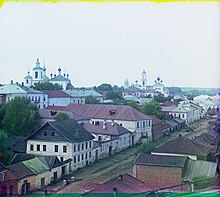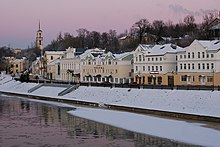Torzhok
Torzhok
Торжок | |
|---|---|
Town of oblast significance[1] | |
 View of Borisoglebsky Monastery | |
| Coordinates: 57°02′N 34°58′E / 57.033°N 34.967°E | |
| Country | Russia |
| Federal subject | Tver Oblast[1] |
| First mentioned | 1139[2] |
| Town status since | 1775[2] |
| Government | |
| • Mayor | Yevgeny Ignatov |
| Elevation | 165 m (541 ft) |
| Population | |
• Total | 47,644 |
| • Subordinated to | Torzhok Okrug[1] |
| • Capital of | Torzhoksky District,[4] Torzhok Okrug[1] |
| • Urban okrug | Torzhok Urban Okrug[5] |
| • Capital of | Torzhok Urban Okrug,[5] Torzhoksky Municipal District[5] |
| Time zone | UTC+3 (MSK |
| Postal code(s)[7] | 172000-172011 |
| Dialing code(s) | +7 48251 |
| OKTMO ID | 28750000001 |
| Website | torzhok-adm |
Torzhok (Russian: Торжо́к) is a town in Tver Oblast, Russia, located on the Tvertsa River along the federal highway M10 and a branch of the Oktyabrskaya Railway division of the Russian Railways. The town is famous for its folk craft of goldwork embroidery. Population: 47,644 (2010 Census);[3] 48,967 (2002 Census);[8] 49,982 (1989 Soviet census).[9]
| Year | Pop. | ±% |
|---|---|---|
| 1897 | 12,700 | — |
| 1939 | 29,309 | +130.8% |
| 1959 | 34,921 | +19.1% |
| 1970 | 45,443 | +30.1% |
| 1979 | 47,214 | +3.9% |
| 1989 | 49,982 | +5.9% |
| 2002 | 48,967 | −2.0% |
| 2010 | 47,644 | −2.7% |
| 2021 | 41,116 | −13.7% |
| Source: Census data | ||
History
[edit]

Torzhok was first mentioned in a chronicle in 1139 as Novy Torg.[2] The Mongols burned it in 1238, but did not proceed northward to Novgorod. At that time, the town commanded the only route whereby grain was delivered to Novgorod. Once Torzhok blocked the route, a great shortage of grain and famine in Novgorod would follow. Consequently, Torzhok was known as a key to the Novgorod Republic and frequently changed hands during feudal internecine wars.
The town was incorporated into the Grand Duchy of Moscow with the rest of the Novgorod Republic in 1478. The armies of a Sigmund the III of Poland frequently ravaged it during the Time of Troubles. During the imperial period, Torzhok was known as an important post station on the highway from Moscow to St. Petersburg. Alexander Pushkin, for instance, used to pass through Torzhok on a number of occasions, and there is a museum dedicated to him in the town.
In the course of the administrative reform carried out in 1708 by Peter the Great, Torzhok was included into Ingermanlandia Governorate (since 1710 known as Saint Petersburg Governorate), and in 1727 Novgorod Governorate split off. In 1775, Tver Viceroyalty was formed from the lands which previously belonged to Moscow and Novgorod Governorates, and Torzhok was transferred to Tver Viceroyalty, which in 1796 was transformed to Tver Governorate. In 1775, Novotorzhsky Uyezd was established, with the center in Torzhok, and Torzhok was granted town status.[2]
On July 12, 1929 the governorates and uyezds were abolished. Novotorzhsky District, with the administrative center in Torzhok, was established within Tver Okrug of Moscow Oblast. On July 23, 1930, the okrugs were abolished, and the districts were directly subordinated to the oblast. On January 29, 1935 Kalinin Oblast was established, and Novotorzhsky District was transferred to Kalinin Oblast.[10] In February 1963, during the abortive administrative reform by Nikita Khrushchev, Torzhoksky, Likhoslavlsky, and Kamensky District were merged into a new district which was called Torzhoksky District. On March 4, 1964, Likhoslavlsky District, and on January 12, 1965, Kuvshinovsky District (which occupied the same area as the former Kamensky District) were re-established. Torzhoksky District retained the new name.[10] In 1990, Kalinin Oblast was renamed Tver Oblast.[11]
Administrative and municipal status
[edit]Within the framework of administrative divisions, Torzhok serves as the administrative center of Torzhoksky District,[4] even though it is not a part of it.[1] As an administrative division, it is incorporated separately as Torzhok Okrug—an administrative unit with the status equal to that of the districts.[1] As a municipal division, Torzhok Okrug is incorporated as Torzhok Urban Okrug.[5]
Economy
[edit]Torzhok has twenty-two large and medium-sized industrial enterprises.[citation needed] Two of them are especially significant. JSC Pozhtekhnika and OAO Torzhok Plant Printing Inks account for 70% of all industrial output.
Transportation
[edit]A railway line which connects Likhoslavl with Soblago via Selizharovo runs through Torzhok. Another railway line branches off in Torzhok and heads south to Rzhev via Vysokoye. Both lines are served by infrequent passenger traffic.
The M10 highway, which connects Moscow and St. Petersburg, passes close to Torzhok. A road to Ostashkov branches off to the west. There is also a road connecting Torzhok with Staritsa. There are local roads as well, with the bus traffic originating from Torzhok.
Architecture
[edit]Architectural monuments of Torzhok include a number of parish churches, dating back to the late 17th or early 18th centuries. Under Catherine the Great, the old monastery of Sts. Boris and Gleb was redesigned in Neoclassical style by a local landowner, Prince Lvov. The main city church is the Savior-Transfiguration Cathedral, founded in 1374. The current edifice was consecrated in 1822. There is also Catherine the Great's diminutive travel palace.
UNESCO World Heritage Site Nomination proposal
[edit]In 2020, a project was presented in the nomination "Historical Center of Torzhok and Estate Architecture of Nikolay Lvov".[12] Its first public discussion took place at a round table organized at the All-Russian Historical and Ethnographic Museum (Torzhok).The nomination project was approved by the leading experts in the field of architectural heritage who participated in the Round Table: Dmitry Shvidkovsky (President of the Academy of Architecture and Construction, Rector of Moscow Architectural Institute), Andrey Batalov, Mikhail Milchik, Konstantin Mikhaylov.
The project provides for the creation of a serial nomination, like the one that unites the main buildings of Andrea Palladio, Nikolai Lvov's creative landmark - "Vicenza and the Palladian Villas of Veneto". In addition to the main classicistic buildings of Torzhok, its general layout and architectural and landscape unity, the nomination was proposed to include buildings in the estates Znamenskoye-Raek, Pryamukhino, Pereslegino, Nikolskoye, Vasilevo.
Military
[edit]Torzhok air base located near the town which has in residence the 344th Center for Combat Employment and Retraining of Personnel of Army Aviation.[13] The center operates the "Golden Eagles" combat helicopter aerobatic team. The 696th Regiment tests all current models and modifications of Russian military helicopters. The center uses Ka-50, Mi-8, Mi-24, Mi-26, and Mil Mi-28Н helicopters for training purposes.
In 2002 the center consisted of the:[13]
- 696th Research-Instructor Helicopter Regiment (Troop Transport Helicopters) (Torzhok, Tver Oblast)
- 92nd Research-Instructor Helicopter Squadron (Sokol, Vladimir Oblast)
- 118th independent Helicopter Squadron (Chebenki, Orenburg Oblast) (though on 1.12.07 absorbed by the 4215th Aircraft Reserve Base)
- 2881st Helicopter Reserve Base (Totskoye-2, Orenburg Oblast)
- Kushalino test range (from 2005) (Military Unit: 15478)
Notable people
[edit]- Mikhail Bakunin (1814–1876), revolutionary anarchist
- Alexej von Jawlensky, painter
- Solomon Shereshevsky, mnemonist
Twin towns – sister cities
[edit]
 Melle, Germany
Melle, Germany Savonlinna, Finland
Savonlinna, Finland Slonim, Belarus
Slonim, Belarus
References
[edit]Notes
[edit]- ^ a b c d e f g Law #34-ZO
- ^ a b c d Энциклопедия Города России. Moscow: Большая Российская Энциклопедия. 2003. pp. 472–474. ISBN 5-7107-7399-9.
- ^ a b Russian Federal State Statistics Service (2011). Всероссийская перепись населения 2010 года. Том 1 [2010 All-Russian Population Census, vol. 1]. Всероссийская перепись населения 2010 года [2010 All-Russia Population Census] (in Russian). Federal State Statistics Service.
- ^ a b Государственный комитет Российской Федерации по статистике. Комитет Российской Федерации по стандартизации, метрологии и сертификации. №ОК 019-95 1 января 1997 г. «Общероссийский классификатор объектов административно-территориального деления. Код 28 254», в ред. изменения №278/2015 от 1 января 2016 г.. (State Statistics Committee of the Russian Federation. Committee of the Russian Federation on Standardization, Metrology, and Certification. #OK 019-95 January 1, 1997 Russian Classification of Objects of Administrative Division (OKATO). Code 28 254, as amended by the Amendment #278/2015 of January 1, 2016. ).
- ^ a b c d Law #4-ZO
- ^ "Об исчислении времени". Официальный интернет-портал правовой информации (in Russian). June 3, 2011. Retrieved January 19, 2019.
- ^ Почта России. Информационно-вычислительный центр ОАСУ РПО. (Russian Post). Поиск объектов почтовой связи (Postal Objects Search) (in Russian)
- ^ Federal State Statistics Service (May 21, 2004). Численность населения России, субъектов Российской Федерации в составе федеральных округов, районов, городских поселений, сельских населённых пунктов – районных центров и сельских населённых пунктов с населением 3 тысячи и более человек [Population of Russia, Its Federal Districts, Federal Subjects, Districts, Urban Localities, Rural Localities—Administrative Centers, and Rural Localities with Population of Over 3,000] (XLS). Всероссийская перепись населения 2002 года [All-Russia Population Census of 2002] (in Russian).
- ^ Всесоюзная перепись населения 1989 г. Численность наличного населения союзных и автономных республик, автономных областей и округов, краёв, областей, районов, городских поселений и сёл-райцентров [All Union Population Census of 1989: Present Population of Union and Autonomous Republics, Autonomous Oblasts and Okrugs, Krais, Oblasts, Districts, Urban Settlements, and Villages Serving as District Administrative Centers]. Всесоюзная перепись населения 1989 года [All-Union Population Census of 1989] (in Russian). Институт демографии Национального исследовательского университета: Высшая школа экономики [Institute of Demography at the National Research University: Higher School of Economics]. 1989 – via Demoscope Weekly.
- ^ a b Справка об изменениях в административно-территориальном делении Тверской губернии - Калининской области (in Russian). Архивы России. Archived from the original on July 9, 2012. Retrieved March 1, 2014.
- ^ "17 июля 1990 года Калинин стал Тверью". Tvernews (in Russian). July 17, 2021.
- ^ Petrov, Arseniy (January 2020). "Historic Town Centre of Torzhok and Country Estate Properties Designed by Nikolay Lvov. UNESCO Nomination".
{{cite journal}}: Cite journal requires|journal=(help) - ^ a b "344th Center for Combat Employment and Retraining of Personnel AA". Ww2.dk. Retrieved September 18, 2022.
- ^ "Породненные связи". torzhok.info (in Russian). Archived from the original on April 14, 2010. Retrieved February 6, 2020.
Sources
[edit]- Законодательное Собрание Тверской области. Закон №34-ЗО от 17 апреля 2006 г. «Об административно-территориальном устройстве Тверской области», в ред. Закона №66-ЗО от 1 октября 2014 г. «О внесении изменения в статью 18 Закона Тверской области "Об административно-территориальном устройстве Тверской области"». Вступил в силу со дня официального опубликования. Опубликован: "Тверские ведомости", №17 (специальный выпуск), 19 апреля 2006 г. (Legislative Assembly of Tver Oblast. Law #34-ZO of April 17, 2006 On the Administrative-Territorial Structure of Tver Oblast, as amended by the Law #66-ZO of October 1, 2014 On Amending Article 18 of the Law of Tver Oblast "On the Administrative-Territorial Structure of Tver Oblast". Effective as of the official publication date.).
- Законодательное Собрание Тверской области. Закон №4-ЗО от 18 января 2005 г. «Об установлении границ муниципальных образований Тверской области и наделении их статусом городских округов, муниципальных районов», в ред. Закона №65-ЗО от 24 июля 2012 г. «О внесении изменения в статью 2 Закона Тверской области "Об установлении границ муниципальных образований Тверской области и наделении их статусом городских округов, муниципальных районов"». Вступил в силу через десять дней после официального опубликования. Опубликован: "Тверские ведомости", №3, 21–27 января 2005 г. (Legislative Assembly of Tver Oblast. Law #4-ZO of January 18, 2005 On Establishing the Borders of the Municipal Formations of Tver Oblast and on Granting Them the Status of Urban Okrugs, Municipal Districts, as amended by the Law #65-ZO of July 24, 2012 On Amending Article 2 of the Law of Tver Oblast "On Establishing the Borders of the Municipal Formations of Tver Oblast and on Granting Them the Status of Urban Okrugs, Municipal Districts". Effective as of the day which is ten days after the official publication.).
Further reading
[edit]- Annette M. B. Meakin (1906). "Torjok". Russia, Travels and Studies. London: Hurst and Blackett. OCLC 3664651. OL 24181315M.





